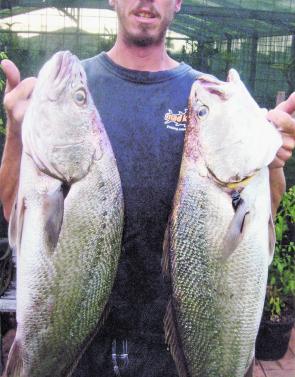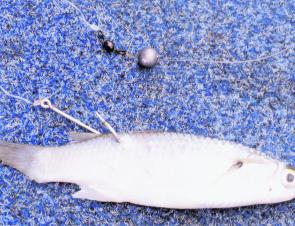Live baiting is probably my most favourite approach to fishing local rivers and estuary systems. There are several types and methods and this month I’ll be looking at the best way to catch mulloway.
A normal day of fishing usually starts off by choosing where I want to fish: look at the tides and wind and where I’ll catch my live bait. Different days and conditions will often dictate different species and locations, but for mulloway fishing I prefer mullet.
Most days I get my live bait from close to where I want to fish, that way you can use the most prolific size bait in a particular area. It’s not always about big fish, big bait but rather the most common bait will fool the local.
Once you’ve caught your livies keep them alive by using a large lidded bucket with holes drilled from every angle and then hung over the side of the boat. This not only keeps them alive, but actually keeps fish in the area due to them struggling beside the boat – they stay much more lively due to the same temperature water flowing through their gills.
For mulloway I always use 25lb mainline and a sinker that should be no heavier than needed to slowly take the bait towards the bottom. You shouldn’t need any bigger than a size 2 as this species is targeted at a tide change or when minimal run is available. Trace is important – 50lb at 1.5m is a minimum, as the live bait needs to swim freely behind your sinker and swivel.
Attach your bait so it gives you the best chance of a hook up. Mulloway tend to approach bait tail first, so my approach is to pin the bait (usually a mullet) between the dorsal fin and top caudal fin. This approach tends to make the bait swim towards the bottom, as mulloway are regularly encountered near the bottom of the water column. You can also cut off the bottom caudal fin, which will help it swim downwards as well.
To catch mulloway, or any species, you need to understand their habits. I’ve found that they prefer areas near a ledge or drop-off, with a nearby bait source. During the tides they usually reside under these ledges resting until the tide slows. Then, when the tide slows, they move around in search of prey.
Areas to look for have a deep hole quite close to a ledge, but also have an open bottom as they can use their power to ambush unsuspecting prey. Their power enables them to run down their food source, so having a livie in these areas puts you in with the best chance of capture.
Baitrunners are the recommended as mulloway can sometimes be hesitant if they feel resistance from the rod, which can result in takes but not hook ups. Preferably have your rod positioned with minimal angle to the water, possibly resting over the gunwale. Once you get a run, don’t strike immediately! You can end up with a scaled bait as they tend to mouth the bait, then remove the scales before swallowing. Once the fish moves off with your bait, then you should engage the reel by winding and engage your drag. Once hooked don’t give them a chance to find their lair.
While fighting a mulloway let it run when needed but don’t go too softly. After a couple of runs they will usually slog it out to the boat but once on the surface they usually give up and roll onto their side; it makes landing quite easy by lifting from the gills or using a landing net.
Hopefully this will provide some handy tips on catching that big slab of silver and once you’ve caught one you’ll be hooked for life. Seeing a mulloway coming up through the water column is so rewarding.
Next month I’ll look at some tips and techniques on where and how to capture king threadfin salmon.
Until then, hope reels are screamin’!
Reads: 1897
Live baiting for mulloway is very productive.

Pin the bait (usually a mullet) between the dorsal fin and top caudal fin.




